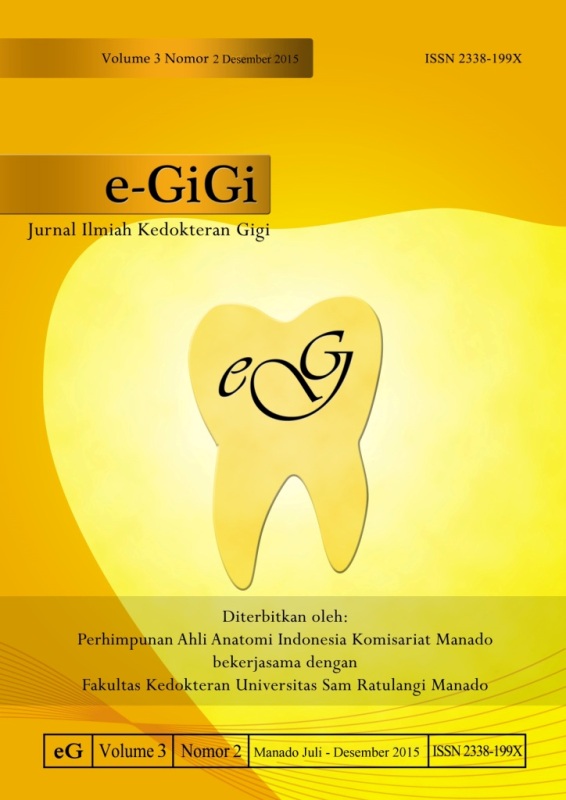GAMBARAN MALOKLUSI BERDASARKAN INDEKS HANDICAPPING MALOCCLUSION ASSESSMENT RECORD (HMAR) PADA SISWA SMA N 9 MANADO
DOI:
https://doi.org/10.35790/eg.3.2.2015.10487Abstract
Abstract: Malocclusion is a condition of abnormal occlusion. If it is not treated it will result in several diseases for the patients. Studies about malocclusion have been done in several cities in Indonesia which showed that many people with malocclusion did not seek for treatment. One of the ways to identify and assess the severity of malocclusion is using the Handicapping Malocclusion Index Assessment Record (Hmar). This study aimed to describe malocclusions in students of SMA N 9 Manado.This was a descriptive cross sectional design. The study was conducted in August 2015 with a total sample of 30 students in grade eleven, obtained by using consecutive sampling. Malocclusion assessment obtained using HMAR consisted of comprising the teeth in one jaw, abnormal tooth relationships of both jaws in occlusion, and dentofacial abnormality examinations. The results showed that based on HMAR most of the malocclusions were in the severe category which were in need of care. Irregular teeth in one jaw in the anterior and posterior regions was the highest form of tooth rotation and tooth crowding. Abnormality in the relationship of both jaws in the occluded jaw position in the anterior region was the highest in the case of excessive nip distance and the lowest cross bites meanwhile in the posterior region was the mesial position of caninus. Concerning dentofacial abnormalities, there was only one palatal bite abnormality. Conclusion: Based on HMAR the highest percentage of malocclusion in this study was severe malocclusion.
Keywords: malocclusion, malocclusion handicapping index assessment record
Abstrak: Maloklusi merupakan bentuk oklusi menyimpang dari normal yang jika tidak dirawat akan mengakibatkan hambatan bagi penderita. Penelitian mengenai maloklusi sudah dilakukan pada beberapa kota di Indonesia yang menunjukan bahwa banyak orang yang mengalami maloklusi tetapi tidak melakukan perawatan. Salah satu cara mengidentifikasi dan menilai keparahan maloklusi yaitu menggunakan Indeks Handicapping Malocclusion Assessment Record (HMAR). Penelitian ini bertujuan untuk mengetahui gambaran maloklusi berdasarkan Indeks HMAR pada siswa SMA N 9 Manado. Penelitian ini bersifat deskriptif dengan rancangan potong lintang. Penelitian ini dilaksanakan pada bulan Agustus tahun 2015 dengan jumlah sampel 30 siswa kelas sebelas, menggunakan consecutive sampling. Penilaian maloklusi diperoleh dengan pemeriksaan berdasarkan indeks HMAR pada model studi. Penilaian meliputi penyimpangan gigi dalam satu rahang, kelainan hubungan gigi kedua rahang dalam keadaan oklusi, dan kelainan dentofasial. Hasil penelitian penyimpangan gigi dalam satu rahang menunjukan persentase tertinggi yaitu gigi rotasi pada rahang atas. Kelainan hubungan gigi kedua rahang dalam keadaan oklusi menunjukkan di regio anterior presentase tertinggi yaitu berupa jarak gigit berlebih dan di regio posterior persentase tertinggi berupa kelainan anteroposterior yang menunjukkan gigi kaninus lebih ke mesial. Kelainan dentofasial hanya ditemukan satu kelainan berupa palatal bite. Simpulan: Gambaran maloklusi berdasarkan indeks HMAR dengan persentase tertinggi yaitu pada kategori maloklusi berat, sangat memerlukan perawatan.
Kata kunci: maloklusi, indeks HMAR
Downloads
How to Cite
Issue
Section
License
COPYRIGHT
Authors who publish with this journal agree to the following terms:
Authors hold their copyright and grant this journal the privilege of first publication, with the work simultaneously licensed under a Creative Commons Attribution License that permits others to impart the work with an acknowledgment of the work's origin and initial publication by this journal.
Authors can enter into separate or additional contractual arrangements for the non-exclusive distribution of the journal's published version of the work (for example, post it to an institutional repository or publish it in a book), with an acknowledgment of its underlying publication in this journal.
Authors are permitted and encouraged to post their work online (for example, in institutional repositories or on their website) as it can lead to productive exchanges, as well as earlier and greater citation of the published work (See The Effect of Open Access).






